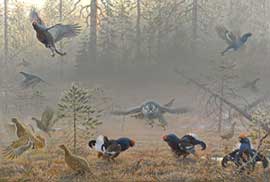|
||||||||||||||||
|
|
||||||||||||||||
|

Humans, Nature and Birds |
From Room 10: Science Art, Birds, and
Nature |
||||
|
|||||
 Plate 69 |
lyre-shaped tails, spreading their white undertail coverts, hissing, and performing mock fights to hold or gain ground. They vie for more centrally located positions because centrality increases their chances for attracting a mate. Skirmishing is less over a specific female than over turf. Female participation is minimal. A female (greyhen) solicits by crouching, pairs bond for a few minutes, and then she leaves the lek. She will rear her young alone. Gorbatov painted his lek in 1995. Like Ehrenstrahl, he conveys action and intensity, but Gorbatov’s predatory goshawk and fleeing grouse look more realistic, even though Ehrenstrahl’s grouse are anatomically accurate. Striking predators and fleeing prey act and react too quickly for us to ob- serve them clearly, but the camera’s eye, with its ability to stop the action, reveals what the hu- man eye fails to detect and enables viewers to see acts like attempted predation that succeed or fail in a flash. The truth of the camera can also pre- pare artists with the equivalent of studies, preliminary compositions showing how a raptor swooping down for a kill looks and how birds recognizing the danger react. Perhaps this is a reason why early scenes of interacting birds, even when produced by an exemplary artist like Ehrenstrahl, appear slightly stiff today compared to those produced since the invention of photography. Both artists portray an edge—a discontinuity between neighboring habitats, |
||||
| Plate
69. Attack, Out of the Mist, 1995, by Vadim Gorbatov © 1995 Vadim Gorbatov Science Art--Birds. © 2008 Darryl Wheye and Donald Kennedy |
|||||